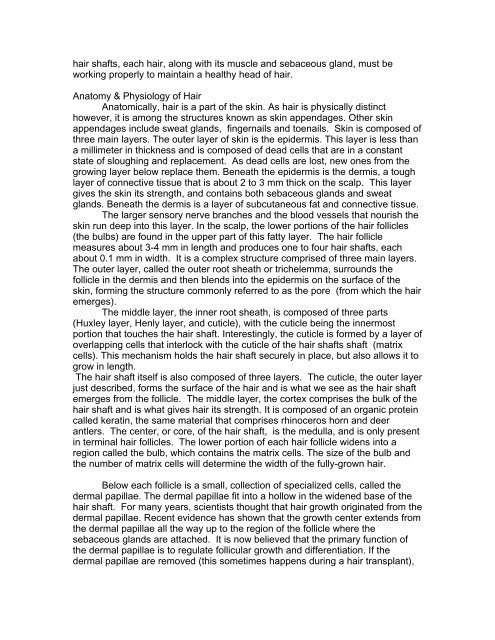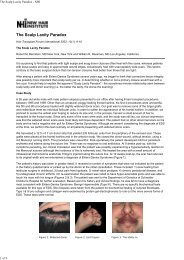The Patient's Guide to Hair Restoration - New Hair Institute
The Patient's Guide to Hair Restoration - New Hair Institute
The Patient's Guide to Hair Restoration - New Hair Institute
Create successful ePaper yourself
Turn your PDF publications into a flip-book with our unique Google optimized e-Paper software.
hair shafts, each hair, along with its muscle and sebaceous gland, must be<br />
working properly <strong>to</strong> maintain a healthy head of hair.<br />
Ana<strong>to</strong>my & Physiology of <strong>Hair</strong><br />
Ana<strong>to</strong>mically, hair is a part of the skin. As hair is physically distinct<br />
however, it is among the structures known as skin appendages. Other skin<br />
appendages include sweat glands, fingernails and <strong>to</strong>enails. Skin is composed of<br />
three main layers. <strong>The</strong> outer layer of skin is the epidermis. This layer is less than<br />
a millimeter in thickness and is composed of dead cells that are in a constant<br />
state of sloughing and replacement. As dead cells are lost, new ones from the<br />
growing layer below replace them. Beneath the epidermis is the dermis, a <strong>to</strong>ugh<br />
layer of connective tissue that is about 2 <strong>to</strong> 3 mm thick on the scalp. This layer<br />
gives the skin its strength, and contains both sebaceous glands and sweat<br />
glands. Beneath the dermis is a layer of subcutaneous fat and connective tissue.<br />
<strong>The</strong> larger sensory nerve branches and the blood vessels that nourish the<br />
skin run deep in<strong>to</strong> this layer. In the scalp, the lower portions of the hair follicles<br />
(the bulbs) are found in the upper part of this fatty layer. <strong>The</strong> hair follicle<br />
measures about 3-4 mm in length and produces one <strong>to</strong> four hair shafts, each<br />
about 0.1 mm in width. It is a complex structure comprised of three main layers.<br />
<strong>The</strong> outer layer, called the outer root sheath or trichelemma, surrounds the<br />
follicle in the dermis and then blends in<strong>to</strong> the epidermis on the surface of the<br />
skin, forming the structure commonly referred <strong>to</strong> as the pore (from which the hair<br />
emerges).<br />
<strong>The</strong> middle layer, the inner root sheath, is composed of three parts<br />
(Huxley layer, Henly layer, and cuticle), with the cuticle being the innermost<br />
portion that <strong>to</strong>uches the hair shaft. Interestingly, the cuticle is formed by a layer of<br />
overlapping cells that interlock with the cuticle of the hair shafts shaft (matrix<br />
cells). This mechanism holds the hair shaft securely in place, but also allows it <strong>to</strong><br />
grow in length.<br />
<strong>The</strong> hair shaft itself is also composed of three layers. <strong>The</strong> cuticle, the outer layer<br />
just described, forms the surface of the hair and is what we see as the hair shaft<br />
emerges from the follicle. <strong>The</strong> middle layer, the cortex comprises the bulk of the<br />
hair shaft and is what gives hair its strength. It is composed of an organic protein<br />
called keratin, the same material that comprises rhinoceros horn and deer<br />
antlers. <strong>The</strong> center, or core, of the hair shaft, is the medulla, and is only present<br />
in terminal hair follicles. <strong>The</strong> lower portion of each hair follicle widens in<strong>to</strong> a<br />
region called the bulb, which contains the matrix cells. <strong>The</strong> size of the bulb and<br />
the number of matrix cells will determine the width of the fully-grown hair.<br />
Below each follicle is a small, collection of specialized cells, called the<br />
dermal papillae. <strong>The</strong> dermal papillae fit in<strong>to</strong> a hollow in the widened base of the<br />
hair shaft. For many years, scientists thought that hair growth originated from the<br />
dermal papillae. Recent evidence has shown that the growth center extends from<br />
the dermal papillae all the way up <strong>to</strong> the region of the follicle where the<br />
sebaceous glands are attached. It is now believed that the primary function of<br />
the dermal papillae is <strong>to</strong> regulate follicular growth and differentiation. If the<br />
dermal papillae are removed (this sometimes happens during a hair transplant),



